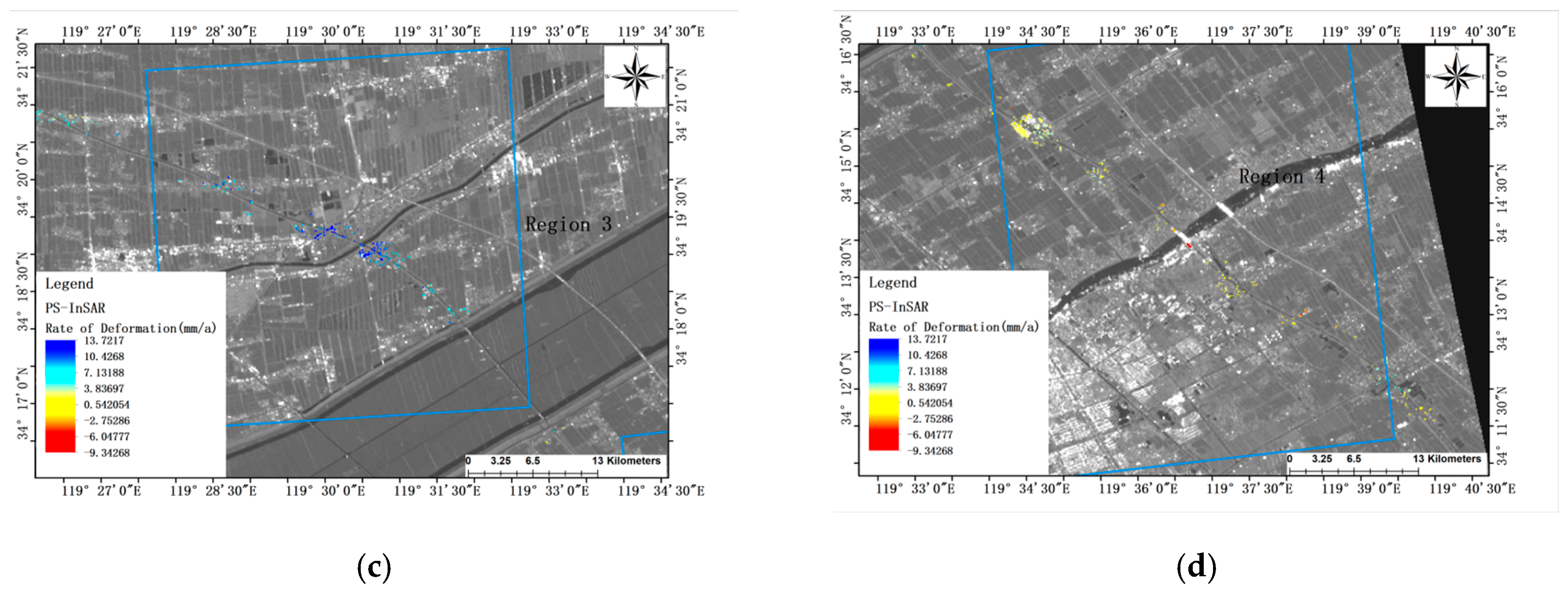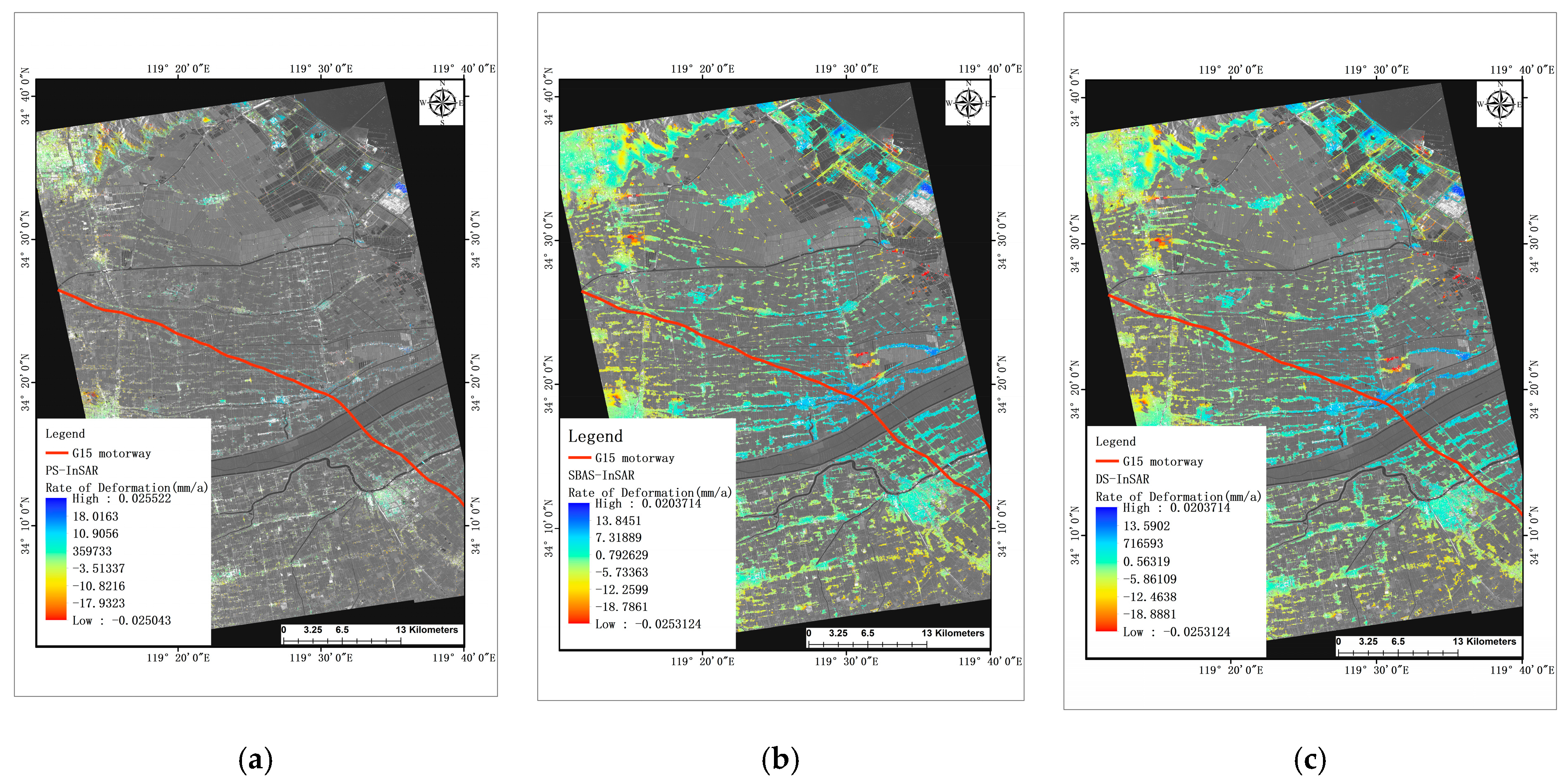Highway Deformation Monitoring by Multiple InSAR Technology
Abstract
:1. Introduction
2. Materials and Methods
2.1. PS-InSAR Technology
2.2. SBAS-InSAR Technology
2.3. DS-InSAR Technology
2.4. Overview of the Study Area
2.5. Data Presentation
3. Results
3.1. Deformation Results Based on PS-InSAR Technique
3.2. Deformation Results Based on SBAS-InSAR Technique
3.3. Deformation Results Based on DS-InSAR Technique
4. Discussion
4.1. Analysis of Results
4.2. Validation of Results
5. Conclusions
Author Contributions
Funding
Institutional Review Board Statement
Informed Consent Statement
Data Availability Statement
Conflicts of Interest
References
- Li, Y.F.; Zuo, X.Q.; Xiong, P.; Yang, F.; You, H.; Sun, L. Highway disaster recognition in central Yunnan area supported by PS-InSAR technology. Sci. Surv. Mapp. 2021, 46, 121–127, 135. [Google Scholar]
- Wang, Z.; Wen, X.; Tang, W.; Liu, H.; Wang, D. Early Detection of Geological Hazards in Longmenshan-Dadu River Area Using Various InSAR Techniques. Geomat. Inf. Sci. Wuhan Univ. 2020, 45, 451–459. [Google Scholar]
- Yu, S.Y.; Chen, L.; Yang, Y.Y.; Zhang, L.X.; Luo, J.Y. Application of InSAR technology in deformation monitoring of Hefei metro. Sci. Surv. Mapp. 2022, 47, 96–102, 109. [Google Scholar]
- Yan, W. Subsidence Monitoring along High Speed Railway in Loess Area Based on DS-InSAR Method. Master’s Thesis, Southwest Jiaotong University, Chengdu, China, 2019. [Google Scholar]
- Liu, B.; Zhang, Y.; Wu, H.; Kang, Y.; Jiang, D. Subsidence Monitoring for Expressway Network in Beijing Based on Time-series InSAR Technique. Bull. Surv. Mapp. 2018, 120–125. [Google Scholar]
- Kampes, B.M. Radar Interferometry; Springer: Dordrecht, The Netherlands, 2006; pp. 21, 211. [Google Scholar]
- Ahmad, M.S.; Lisa, M.; Khan, S. Assessment and mapping of landslides in steep mountainous terrain using PS-InSAR: A case study of Karimabad Valley in Chitral. Kuwait J. Sci. 2024, 51, 100137. [Google Scholar] [CrossRef]
- Kou, P.; Xu, Q.; Jin, Z.; Tao, Y.; Yunus, A.P.; Feng, J.; Pu, C.; Yuan, S.; Xia, Y. Analyzing gully erosion and deposition patterns in loess tableland: Insights from small baseline subset interferometric synthetic aperture radar (SBAS InSAR). Sci. Total Environ. 2024, 916, 169873. [Google Scholar] [CrossRef] [PubMed]
- Ma, P.; Wu, Z.; Zhang, Z.; Au, F.T.K. SAR-Transformer-based decomposition and geophysical interpretation of InSAR time-series deformations for the Hong Kong-Zhuhai-Macao Bridge. Remote Sens. Environ. 2024, 302, 113962. [Google Scholar] [CrossRef]
- Ramirez, R.A.; Lee, G.-J.; Choi, S.-K.; Kwon, T.-H.; Kim, Y.-C.; Ryu, H.-H.; Kim, S.; Bae, B.; Hyun, C. Monitoring of construction-induced urban ground deformations using Sentinel-1 PS-InSAR: The case study of tunneling in Dangjin, Korea. Int. J. Appl. Earth Obs. Geoinf. 2022, 108, 102721. [Google Scholar] [CrossRef]
- Zhu, J.; Yang, Z.; Li, Z. Recent progress in retrieving and predicting mining-induced 3D displace-ments using InSAR. Acta Geod. Et Cartogr. Sin. 2019, 48, 135–144. [Google Scholar] [CrossRef]
- Blanco, P.; Mallorqui, J.; Duque, S.; Navarrete, D. Advances on DInSAR with ERS and ENVISAT Data Using the Coherent Pixels Technique (CPT). In Proceedings of the 2006 IEEE International Symposium on Geoscience and Remote Sensing, Denver, CO, USA, 31 July–4 August 2006; pp. 1898–1901. [Google Scholar]
- Costantini, M.; Falco, S.; Malvarosa, F.; Minati, F. A New Method for Identification and Analysis of Persistent Scatterers in Series of SAR Images. In Proceedings of the IGARSS 2008—2008 IEEE International Geoscience and Remote Sensing Symposium, Boston, MA, USA, 7–11 July 2008; pp. II-449–II-452. [Google Scholar]
- Costantini, M.; Falco, S.; Malvarosa, F.; Minati, F.; Trillo, F.; Vecchioli, F. Persistent Scatterer Pair Interferometry: Approach and Application to COSMO-SkyMed SAR Data. IEEE J. Sel. Top. Appl. Earth Obs. Remote Sens. 2014, 7, 2869–2879. [Google Scholar] [CrossRef]
- Samsonov, S.V.; d’Oreye, N. Multidimensional Small Baseline Subset (MSBAS) for Two-Dimensional Deformation Analysis: Case Study Mexico City. Can. J. Remote Sens. 2017, 43, 318–329. [Google Scholar] [CrossRef]
- Ma, Z.; Liu, J.; Aoki, Y.; Wei, S.; Liu, X.; Cui, Y.; Hu, J.; Zhou, C.; Qin, S.; Huang, T.; et al. Towards big SAR data era: An efficient Sentinel-1 Near-Real-Time InSAR processing workflow with an emphasis on co-registration and phase unwrapping. ISPRS J. Photogramm. Remote Sens. 2022, 188, 286–300. [Google Scholar] [CrossRef]
- Wang, S.; Yang, K.M.; Ding, X.M.; Hou, Z.X.; Li, Y.R.; Li, Y.X. Safety analysis on dynamic subsidence of buildings and roads in mining area monitored by PS-InSAR. J. Saf. Sci. Technol. 2022, 18, 111–117. [Google Scholar]
- Chen, J.N. Monitoring and Analysis of Land Subsidence in Typical Plain Areas Based on SBAS-InSAR—Taking Nanjing and Fuyang as Examples. Master’s Thesis, East China University of Technology, Nanchang, China, 2022. [Google Scholar]
- Lu, L. Study on DS-InSAR Method for Monitoring Time-series Surface Deformation in Mining Area. Master’s Thesis, China University of Mining and Technology, Xuzhou, China, 2020. [Google Scholar]
- Jiangsu Provincial Department of Transportation. Jiangsu Highway Network Planning (2017–2035). Available online: http://jtyst.jiangsu.gov.cn/art/2018/10/1/art_48280_7848597.html (accessed on 20 October 2023).
- Pan, C.; Jiang, L.; Sun, Q.; Jiang, Y. Monitoring and analyzing Chengdu ground subsidence based on InSAR technology by using sentinel-1radar image. J. Geod. Geodyn. 2020, 40, 198–203. [Google Scholar]
- Hooper, A.; Zebker, H.; Segall, P.; Kampes, B. A new method for measuring deformation on volcanoes and other natural terrains using InSAR persistent scatterers. Geophys. Res. Lett. 2004, 31, L23611. [Google Scholar] [CrossRef]
- China Railway Fifth Survey and Design Institute Group Co., Ltd. Tianlou Guan River Special Bridge Engineering Geological Investigation Report. Available online: https://jz.docin.com/p-270208665.html (accessed on 7 April 2024).
- TB 10012-2019; Code for Geology Investigation of Railway Engineering. China Railway Publishing House: Beijing, China, 2019.









| Technique | SBAS-InSAR | PS-InSAR | DS-InSAR |
|---|---|---|---|
| SBAS-InSAR | 1 | ||
| PS-InSAR | 0.948 | 1 | |
| DS-InSAR | 1 | 0.948 | 1 |
| SBAS-InSAR | PS-InSAR | DS-InSAR | |
|---|---|---|---|
| Average (mm/a) | 1.22 | 1.41 | 1.73 |
Disclaimer/Publisher’s Note: The statements, opinions and data contained in all publications are solely those of the individual author(s) and contributor(s) and not of MDPI and/or the editor(s). MDPI and/or the editor(s) disclaim responsibility for any injury to people or property resulting from any ideas, methods, instructions or products referred to in the content. |
© 2024 by the authors. Licensee MDPI, Basel, Switzerland. This article is an open access article distributed under the terms and conditions of the Creative Commons Attribution (CC BY) license (https://creativecommons.org/licenses/by/4.0/).
Share and Cite
Zhao, D.; Yao, H.; Gu, X. Highway Deformation Monitoring by Multiple InSAR Technology. Sensors 2024, 24, 2988. https://doi.org/10.3390/s24102988
Zhao D, Yao H, Gu X. Highway Deformation Monitoring by Multiple InSAR Technology. Sensors. 2024; 24(10):2988. https://doi.org/10.3390/s24102988
Chicago/Turabian StyleZhao, Dan, Haonan Yao, and Xingyu Gu. 2024. "Highway Deformation Monitoring by Multiple InSAR Technology" Sensors 24, no. 10: 2988. https://doi.org/10.3390/s24102988





